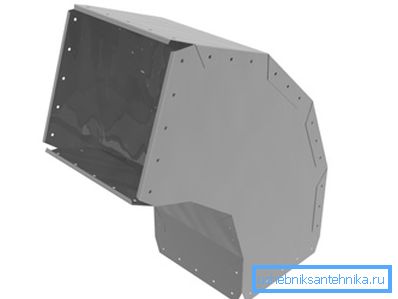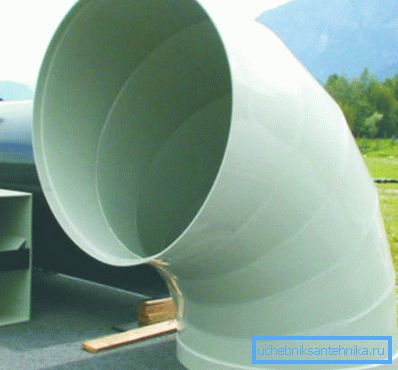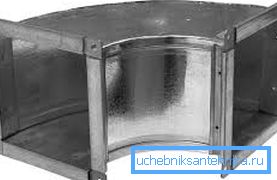Taps for ventilation: main varieties and their distinctive
When installing a kitchen hood with a vent into the ventilation, in addition to the unit itself, an air duct is used, which in turn connects the hood to the ventilation shaft. The duct is formed from rectangular or round pipes and fittings that allow you to change the direction of the route.
A similar principle is used for industrial ventilation systems, where, in accordance with the constructional and specific features of a construction object, straight pipes alternate with shaped elements that allow you to change the direction of the route at the required angle.

In this article we will talk about the main types of shaped elements used to change the direction of the duct.
Design features

A bend (knee) is a connecting element in the ductwork that allows you to change the course of the ventilation system with your hands. Modern bends on sale are products manufactured using various materials, including black steel, stainless or galvanized steel, plastic (for installation of household extracts), etc.
A separate kind of knees due to design features, is used not as connecting elements when constructing air ducts, but as industrial external lateral emissions. In such elements, special barrier walls or percola, which prevent the penetration of debris and foreign matter into the pipes, are installed.

Important: The area of the vent is an important parameter to consider when choosing a product.
The area in this case is determined by the formula Sc = L x 2,778 / V.
- Sc is the calculated area
- L is the flow rate of air passing through the pipe.
- V is the speed at which air moves through ventilation,
- 2,778 is a coefficient according to which the dimensions are consistent (for example, meters and centimeters).
Classification according to the type of production materials

Based on the type of production material used, bends used in the construction of ventilation systems are divided into the following modifications:
- Galvanized vent lines - made of black steel, coated with a thin layer of zinc. The product range is represented by modifications used in the construction of industrial and domestic systems.
The main advantage of these products is an affordable price combined with corrosion resistance.
- Modifications made of stainless steel are rarely used, since their price is high, and the weight exerts a significant load on the surface of the walls or floors. As a rule, stainless steel products are made with a small diameter and are used exclusively in the formation of domestic ventilation systems.
- Black steel elbows are popular in the construction of industrial ducts. The relevance of these products is due to low cost. The use of such modifications is not recommended when building systems designed for exhaust air with excessive humidity.
- Plastic modifications are made of polymeric materials resistant to mechanical loads and deformations. Products are used only in the manufacture of household ventilation.
Other selection criteria

After we have decided on what production materials the ventilation bends are made of, consider the remaining criteria, according to which the instruction for choosing the appropriate modification is determined.
- In accordance with the configuration of the cross section, round and rectangular products are distinguished.. Directly on the performance of the system, the shape of the cross section does not affect in any way. The choice of cross-sectional configuration, most often, is motivated by the shape of the exhaust opening on the ventilation equipment used.
Important: The difference in the configuration of the sections can be compensated by using special adapters. But we must remember that the use of adapters reduces the aerodynamic duct and adversely affects the performance of the system as a whole.
- Metal products can be made of steel with a sheet thickness from 0.55 to 8 mm.
When assembling household systems, knees of the thinnest sheet steel are used, the weight of which will not have a mechanical effect on the wall or the covering on which the ventilation duct is fixed. When assembling industrial systems, products made of thick sheet steel are used.
This is because with a large diameter of the duct only due to the increased wall thickness, you can save the configuration of the cross section.
- In accordance with the type of connection, flanged-type elbows are used (used for assembling industrial systems) or nipple-type modifications, where a sealing rubber is used to achieve the required tightness.
Modifications with a nipple connection are characterized by simplicity and tight deadlines for installation. But such knees are used only in household systems, where the air supply capacity is low.
- In accordance with the rotation angle, the modifications calculated at 45 and 90 degrees are different.. However, at the request of the customer, bends can be made, the angle of which is selected in accordance with certain features of the construction site where the installation is being carried out.
Important: The turning radius is a characteristic characteristic of the knee with a circular cross section. In standard products, the turning radius is equal to the diameter of the section. If necessary, this parameter can be changed in accordance with the needs of the customer.
Is it possible to do without the assembly of the duct

If the configuration of the room does not imply the possibility of conducting the duct to the outside or into the ventilation shaft, exhaust hoods can be applied without being vented to the ventilation.
At the heart of such devices are applied absorption filters that absorb and accumulate unpleasant odors. Hoods for the kitchen without exhaust in the ventilation, will refuse to install the duct. But filters, as the filling, it is necessary to change, otherwise their performance decreases.
Conclusion
Now we know what the instruction for choosing ducts for assembling an air duct is and we can choose those components with which ventilation will have an enviable performance (see also the article Heaters for ventilation: types, installation, calculation).
More useful information can be found by watching the video in this article.